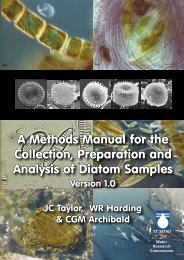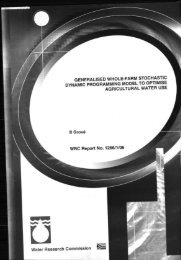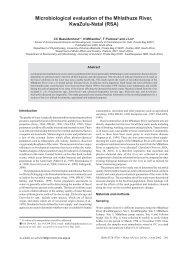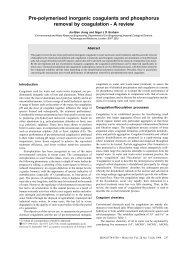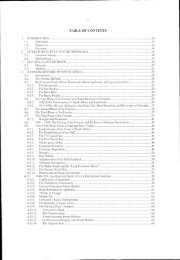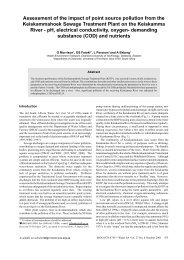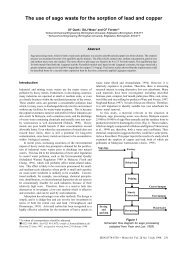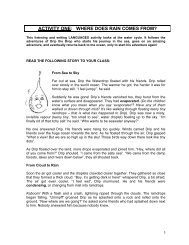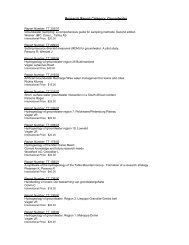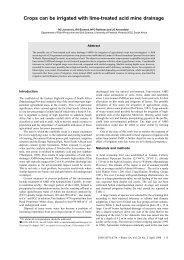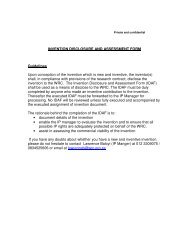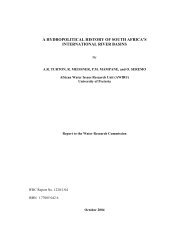and the Efficacy of Pit Latrine Additives - Water Research Commission
and the Efficacy of Pit Latrine Additives - Water Research Commission
and the Efficacy of Pit Latrine Additives - Water Research Commission
- No tags were found...
You also want an ePaper? Increase the reach of your titles
YUMPU automatically turns print PDFs into web optimized ePapers that Google loves.
4 Conclusions from Set 1 <strong>and</strong> Set 2 experiments<br />
The purpose <strong>of</strong> <strong>the</strong>se experiments was to determine whe<strong>the</strong>r addition <strong>of</strong> moisture <strong>and</strong>/or NaHCO 3 to<br />
samples <strong>of</strong> fresh VIP contents had a statistically significant effect on gas production rate under anaerobic<br />
conditions. The gas production rate was understood to be correlated to <strong>the</strong> rate <strong>of</strong> anaerobic degradation <strong>of</strong><br />
<strong>the</strong> VIP contents, <strong>and</strong> an enhanced gas production rate would thus be an indication <strong>of</strong> improved stabilisation<br />
rates. Experiments from Set 2 showed that VIP contents alone (with no additional water or NaHCO 3 had<br />
negligible gas production across three replicates; however, addition <strong>of</strong> water only or water <strong>and</strong> NaHCO 3<br />
resulted in statistically significant increases in gas production. It was not possible to determine whe<strong>the</strong>r <strong>the</strong><br />
addition <strong>of</strong> NaHCO 3 had any effect on gas production rate (ei<strong>the</strong>r positive or negative)<br />
It was also observed that increasing <strong>the</strong> amount <strong>of</strong> water at <strong>the</strong> beginning <strong>of</strong> <strong>the</strong> experiment could have <strong>the</strong><br />
opposite effect, i.e. reduced gas production rates as a result <strong>of</strong> absorption <strong>of</strong> CO 2 in <strong>the</strong> moisture (See<br />
Appendix B for details). However, after a certain amount <strong>of</strong> time, CO 2 absorption ceased as <strong>the</strong> inorganic<br />
carbon content in <strong>the</strong> aqueous phase approached saturation with respect to <strong>the</strong> headspace <strong>of</strong> <strong>the</strong><br />
experiment. 24 Thereafter, <strong>the</strong> gas production rate (as opposed to <strong>the</strong> cumulative amount <strong>of</strong> gas produced)<br />
was greater for experiments with more added water than those with less.<br />
The conclusion <strong>of</strong> this work were that increasing moisture content <strong>of</strong> VIP contents has <strong>the</strong> potential to<br />
increase <strong>the</strong> rate <strong>of</strong> stabilisation <strong>of</strong> buried organic material in <strong>the</strong> pit.<br />
Significantly greater amounts <strong>of</strong> gas were produced per test unit for Set 2 units relative to Set 1 units. This<br />
supports <strong>the</strong> hypo<strong>the</strong>sis that <strong>the</strong> generally poor performance <strong>of</strong> all treatments in Set 1 was less a function <strong>of</strong><br />
<strong>the</strong> treatments than that <strong>the</strong> VIP contents used were already well digested <strong>and</strong> <strong>the</strong>refore inherently resistant<br />
to fur<strong>the</strong>r degradation.<br />
This study supports <strong>the</strong> motivating hypo<strong>the</strong>sis that <strong>the</strong> moisture content generally observed in VIP material is<br />
low <strong>and</strong> may be a limiting factor in <strong>the</strong> rate <strong>of</strong> anaerobic digestion that may occur in <strong>the</strong> buried pit contents.<br />
This implies that increasing <strong>the</strong> moisture content in <strong>the</strong> pit has <strong>the</strong> potential to increase stabilisation rates in<br />
<strong>the</strong> pit. These broad findings are supported by literature which state that <strong>the</strong> rate <strong>of</strong> accumulation in pits is<br />
lower in wet pits than in dry pits (Franceys et al., 1992).<br />
This study indicated that addition <strong>of</strong> NaHCO 3 resulted in no significant effect on gas production rate, <strong>the</strong>reby<br />
refuting <strong>the</strong> hypo<strong>the</strong>sis that <strong>the</strong>re is insufficient buffering capacity in pit latrine contents to support stable<br />
anaerobic digestion. This could be explained in <strong>the</strong> context <strong>of</strong> <strong>the</strong> general <strong>the</strong>ory <strong>of</strong> processes in pit latrines<br />
(Section 3.1) in that if a significant proportion <strong>of</strong> <strong>the</strong> biological conversion <strong>of</strong> organic material in <strong>the</strong> pit latrine<br />
happens aerobically on <strong>the</strong> surface <strong>of</strong> <strong>the</strong> pit three effects would reduce <strong>the</strong> pH buffering requirement in pit<br />
latrine contents:<br />
The buffering capacity requirement for aerobic degradation is less than for anaerobic digestion since<br />
<strong>the</strong>re is no accumulation <strong>of</strong> acid intermediates in aerobic degradation.<br />
There will be a smaller load <strong>of</strong> organic material requiring anaerobic digestion, <strong>and</strong> thus a smaller<br />
overall buffering requirement (than if <strong>the</strong> entire load <strong>of</strong> organic material entering <strong>the</strong> pit were<br />
considered)<br />
The process <strong>of</strong> aerobic degradation will increase <strong>the</strong> overall alkalinity <strong>of</strong> <strong>the</strong> contents <strong>of</strong> <strong>the</strong> pit latrines<br />
24<br />
This is a somewhat simplistic explanation since <strong>the</strong> “equilibrium” in each experiment will be dynamic: it will depend on pH, headspace<br />
gas composition <strong>and</strong> pressure, relative rate <strong>of</strong> production <strong>of</strong> CO 2 <strong>and</strong> CH 4 , frequency <strong>of</strong> headspace venting <strong>and</strong> aqueous phase<br />
concentrations <strong>of</strong> a range <strong>of</strong> chemical species.<br />
88



